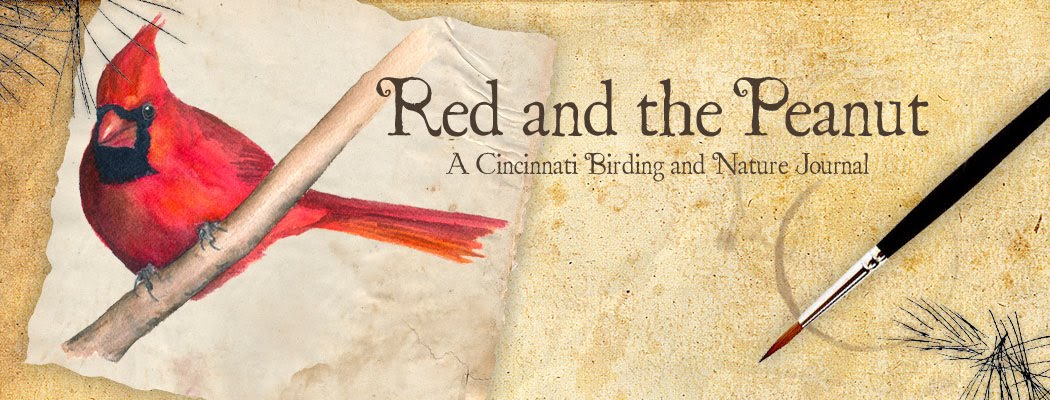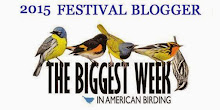One afternoon back in October, I was walking through a stand of pines at Fort Ancient listening for birds. Up ahead I saw several little golf balls on the ground, and headed over for a closer look. As I got closer, I could see they weren't golf balls, but early developmental stages of amanita mushrooms, maybe the yellow and white varieties of Amanita muscaria...the famous Fly Agaric, but maybe not. I don't know enough to positively ID the species. Poisonous? Probably. Hallucinogenic? Maybe. Cool looking? Definitely...

From a distance, this amanita mushroom looked like a golf ball teed up and ready to go! The volva of the mushroom (the cup at its base) was so perfect I had to stop for a closer look.
I don't know a lot about mushrooms. I'm good with Shaggy Manes and puffballs because they are are so distinctive and I've seen a lot of them, but since I'm not a mushroom hunter and don't eat wild mushrooms, I never took the time to learn details about the poisonous varieties. When I saw this one, however, I knew something was up, because I saw the "cup" at its base. The only thing I remembered about poisonous amanita mushrooms from past reading was to watch out for the "cup of poison," which is what I called it as a memory jog. I wanted to know more, so to help me learn about poisonous amanita mushrooms, I bought the following two books:
- "Mushrooms Demystified," by David Arora. This book is 958 pages long and contains extensive scientific descriptions and photographs of mushrooms. Pretty much everything you need. I learned a ton...
- "Chanterelle Dreams, Amanita Nightmares--the Love, Lore, and Mystique of Mushrooms," by Greg Marley. This book contains detailed historical, literary and scientific references, ancient lore, recipes, and even poetry--really interesting, and I learned another ton...
How to identify poisonous amanita mushrooms
Amanita mushrooms are not the only poisonous mushrooms out there, but they account for 90% of all fatalities, and since they were the mushrooms I saw and photographed, that's what I'll cover here. There are three easy ways to spot an amanita mushroom:
1. Look for remnants of a "universal veil" by the presence of a volva (cup) at the base and warts or scales on the cap. Amanita mushrooms have a universal veil that encapsulates the mushroom when it forms. At this stage, it's called a mushroom button and resembles an egg (at this stage it can also resemble a puffball mushroom, but if you slice the amanita open, you'll be able to see the form of the amanita's cap and gills inside--a puffball would be solid). As the mushroom button grows, the stem lengthens pushing the cap up, and the veil separates. The volva forms at the base (which is often underground, so you may need to dig down to find it). As the mushroom gets taller the volva may become less distinct. On the cap, the universal veil shows as warts or scales.

...the volva looks less like a cup as the mushroom grows, but is still clearly bulbous.
2. Look for remnants of a "partial veil" by the presence of an annulus (or ring) on the stem. To complicate things, another veil is sometimes present, called a "partial veil." It only covers the mushroom's gills and stays intact until the mushroom is old enough to form spores. As the gills mature, the partial veil pulls away and leaves behind a ring called the annulus. The annulus ring can come in many forms. In the following photo, it is easy to see. It can also be skirt like, collar like, or barely visible.

...the annulus forms a ring on the stem as the partial veil pulls away during growth. This annulus is distinct, but often they are not this obvious.
3. Look for white gills and a white spore print. Gills are the rib-like structures under the cap where spores are dispersed. Amanitas have white or pallid gills. To take a spore print, lop off the stem and press the gills (the underside of the mushroom cap) against a piece of white paper. Spore color can be black, gray, yellow, etc. Amanitas, however, will always leave behind a white spore print.

...even as the amanita mushroom ages, the gills stay light or white.

...powdery looking white spores line the edges of the gills. When you press the gills against paper, they leave a white spore print behind.
What kind of amanita mushroom is it?
There are lots of types of amanita mushrooms. Deadly poisonous are the "death cap" and "destroying angel" amanitas, but not all are poisonous and some are hallucinogenic. I don't know the amanita species of the mushrooms I found at Fort Ancient. They may have been the muscaria magic mushrooms--the sorta-kinda deadly if you eat large quantities of them, but mostly you'll just experience intestinal distress, vomiting...or hallucinations and inebriation, but I don't know enough to be sure.

Are the whitish mushrooms I found Amanita muscaria var. alba? Alba has a white to grayish-buff cap, which seems to match this amanita, but alba is also supposed to be rare...
...there were two other varieties of Amanita scattered under the pines along with this white-colored mushroom...a red-capped mushroom and a yellow-capped variety:

I think, because the gills are yellow and there was no real ring on the stem this is Amanita parcivolvata and not muscaria.

...the bright yellow of this cap caught my eye. It was so much more intense than the white version. My guess is Amanita muscaria var. formosa. If there are experts out there, please let me know which varieties I have here.
When I wrote about Poison Hemlock and Queen Ann's Lace a few months ago, Matty wrote a little poem to help remember how to tell the two plants apart (here), so following in his footsteps, I put a rhyme together to help remember how to identify a poisonous amanita mushroom...
A tiny cup of poison,with gills of lily white,when accompanied with warts on top,could give you quite a fright!















